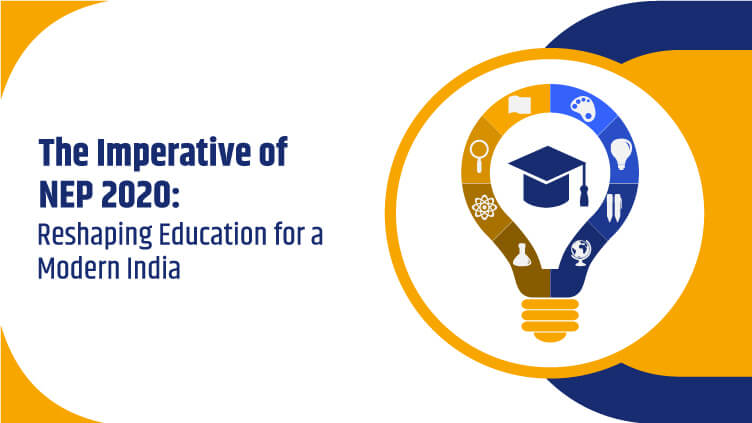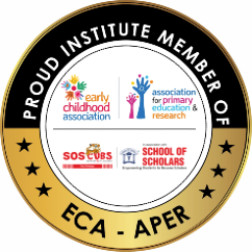The Imperative of NEP 2020: Reshaping Education for a Modern India
Introduction:

The New Education Policy (NEP) 2020 removed the old learning and rigid syllabus with brand new dynamics of the 21st century. It signifies holistic education, early childhood care, a flexible evaluation system, skill development, integrated advanced technology, teacher training, and higher education transformations. It is a beacon of hope and a blueprint for reform. Its implementation is the clarion call for a transformed education landscape.
Why NEP 2020 is Not Just another Policy but a Necessity

Holistic Development, Not Factory Production:
The National Education Policy 2020 has changed its approach towards the Indian education system. This policy refused to make students memorize syllabus books mechanically. Instead, it tells to nurture students with critical thinking and adaptability to real-world challenges. Highlighted essential skills are;
Holistic Development
This policy focuses on inclusive education, and extracurricular activities such as art and culture, design and craft, music, dance, and sports. These activities bring analytical power, decision-making, and critical thinking to students.
Early Childhood Care
This policy advocates quality education for preschoolers belonging to the age group of 3 to 6 years. It fosters creativity, joyful learning, kindness, attitude and aptitude. It has a substantial impact on the positive attitude and overall mental health.
Flexible Evaluation System
The syllabus and exam pattern have been completely changing. It is based on conceptual understanding, applications and scope by promoting project-based learning.
Integration of Advanced Technology
Innovative teaching methodology lensed with advanced technology puts students at the top of their learning journey, focusing on developing their educational competencies to explore the modern world.
Certified Teachers
Teacher training and professional development have been core parts of this policy to foster trained faculty or subject experts. Innovative teaching methodology comes out only when teachers are well-trained in their subjects. This policy recommends regular training and support to teachers to enable them to use digital tools and resources.
Setting the Foundation Right:

The tender years between 3 and 8 are crucial for brain development and foundational learning. NEP 2020 recognizes it by focusing unprecedentedly on quality early childhood education. Laying this groundwork ensures that every child starts with a solid foundation for lifelong learning regardless of background.
Breaking the Shackles of Rigid Structures:

The 10+2 structure, a relic of a bygone era, confines students to narrow silos of knowledge. NEP 2020 proposes a flexible 5+3+3+4 system, allowing students to explore diverse subjects, experiment with their interests, and chart their unique learning paths. This flexibility breaks down artificial barriers and fosters interdisciplinary knowledge, a vital skill for navigating the interconnected world of tomorrow.
Skilling for Employability:

The traditional education system must often equip students with the skills required for the modern workforce. NEP 2020 integrates vocational education seamlessly into mainstream education, making it accessible and valued. This focus on skilling ensures that young people graduate with qualifications and practical skills that guarantee employability and economic empowerment.
Empowering Teachers, the Architects of Education:

Reform can only succeed with empowered and motivated teachers. NEP 2020 elevates the teaching profession, attracting the best talent with better pay, continuous professional development, and increased autonomy. This investment in teachers translates into better student learning outcomes and creates a positive learning environment.
Leveraging Technology, Not Being ruled by it:

Technology isn’t a teacher replacement but a powerful tool to enhance learning. NEP 2020 embraces technology to improve access, personalise learning, and make education more engaging. However, it emphasises the importance of human connection and critical thinking, ensuring that technology empowers, not disrupts, the learning process.
The implementation of NEP 2020 has its challenges. It requires a collaborative effort from the government, educators, parents, and the community. But the potential rewards are immense. By dismantling outdated structures, fostering holistic development, and equipping students with the skills for the future, NEP 2020 can unleash the true potential of India’s youth and propel the nation towards a brighter future. This is not just an education policy but a commitment to building a new India where every child can thrive and contribute to the nation’s progress.
So, let us join hands, embrace the spirit of NEP 2020, and embark on this transformative journey. Let’s build an education system not just about grades and degrees but about nurturing curiosity, igniting imagination, and empowering the next generation to be the architects of their destinies. The time for reform is now, and the future of India depends on it.
Conclusion:
NEP 2020 offers hope and reform regarding the new education system. This NEP 2020 education policy aims to explore the potential of youth for a brighter future. It focuses on holistic growth and development, a joyful learning experience at school age, providing flexible evaluation systems, upgradation for teachers, conceptual-based teaching methods, and integrating advanced technology into education. Although some challenges may remain, the goal is to pave the way for a better future for India’s young minds.
Some Questions May Come To Your Mind
Q1. What is the purpose of NEP 2020?
After 3 decades, a revised education policy was introduced in India with its new version of education policy. On 30th July 2020, the Education Policy was drafted under the guidance of the Indian Ministry of Human Resource and Development (MHRD). It aims to educate, encourage, and empower youth.
Q2. What does the National Education Policy in 2020 suggest?
During 2017-2018, India sanctioned a budget of approximately 4.43% of its Gross Development Product (GDP) in the education sector. After the announcement of the new NEP in 2020, the budget has risen to 6% of its GDP.
Q3. Who drafted the National Education Policy (NEP) 2020 in India?
The Indian government revised its National Education Policy after 34 years. Dr. K. Kasturiranga drafted this policy along with his team. He was the former ISRO chief. He chaired the NEP drafting committee that was introduced in 2020.
Q4. What does the National Education Policy (NEP) 2020 consist of?
The new NEP 2020 recommends that the educational institutions in India should provide a quality academic education. Additionally, foreign countries are permitted to establish their universities here. The NEP also issued guidelines regarding the fee structures for both private and public universities.










